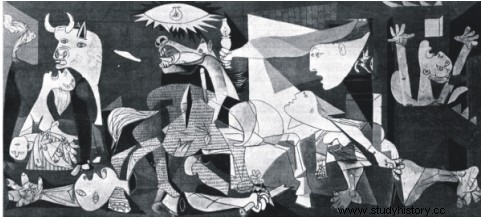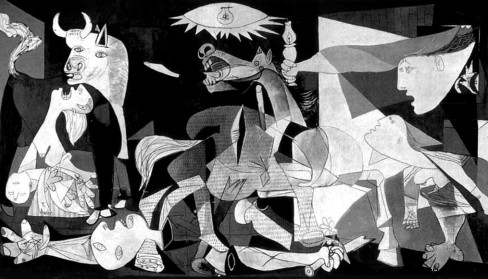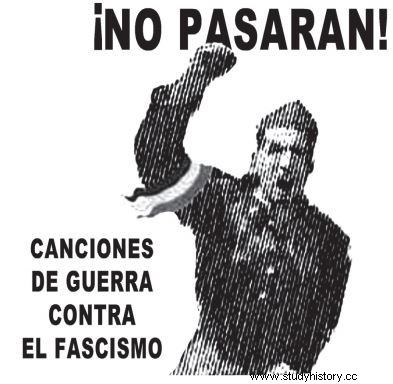Question 02 - UNIFOR - 2006.2 - In April 1937, Germany tested the efficiency of its warplanes by bombing the Spanish village of Guernica. The horror of the massacre led Pablo Picasso to record the fact on a panel that is now in Madrid, after having spent many years in the Museum of Modern Art in New York.
 |
| Guernica, 1937. Picasso's most famous work tells the horror of war. |
(A) a Civil War was taking place, involving the troops of General Franco and the Popular Front government that governed the Spanish Republic.
(B) the Revolution of the Carnations, led by young soldiers in defense of the democratization of the country.
(C) a workers' and popular rebellion, led by the Spartacist League that was trying to come to power.
(D) the Spanish-American war in which Spain lost its American territories.
(E) the signing of the Maastricht Treaty, which created the European Union, preventing the participation of Germany.
Question 03 - UFU 1999- 1 - History - In July 1936, General Francisco Franco, under the pretext of a communist advance, led a military revolt to overthrow the Republic, starting the Spanish Civil War. On his side were the majority of the Catholic Church and sectors of the middle class and the Army. Regarding this war, it is correct to say that
I- the Russians remained neutral while Germany and Italy fought against Franco on the side of the republicans, being defeated by the International Brigades of communists and anarchists.
II- the most sensitive image of the horrors of the Spanish civil war can be seen in the work of the plastic artist Pablo Picasso, who portrayed, in Guernica, all his indignation at the German bombing of the Spanish city.
III- with the military help of Italy and Germany and the support of the Catholic Church, General Franco managed, in 1939, to overthrow the republican resistance, opening the way for the expansion of totalitarian regimes in Europe and installing in Spain a dictatorship that would last until 1975.
IV- among the factors of dissatisfaction of the conservative sectors, agglutinated in the Falange group and led by Franco, was the victory of the Popular Front coalition and the left movements in the 1936 elections.
Check
A) if only I and III are correct.
B) if only I, II and III are correct.
C) if only II is correct.
D) if all are correct.
E ) if only II, III and IV are correct.
Question 04 - UERJ 2016.1 -

Removal of the last equestrian statue of General Francisco Franco, in the city of Santander, Spain, in December 18, 2008. http://g1.globo.com
In 2007, in Spain, a law was passed that made it possible to compensate victims of the Civil War (1936-1939) and the government of Francisco Franco (1939-1975). The action depicted in the photograph is also a result of this law. In the context of complaints and investigations about crimes committed by the Francoist government, the removal of the equestrian statue is associated with the following proposal:
(A) rejection of political history
(B) reinforcement of national identity
(C) redistribution of cultural heritage
(D) resizing of social memory
Question 05 - UFT 2018.1 - Transfer - In July 1936, after a brief popular government by Manoel Azaña, who implemented agrarian reform and increased wages, a military rebellion began in Morocco. The country then became involved in a civil war that lasted until 1939 causing one million deaths. The fighting gained historical significance from a struggle between fascism and democracy. The winning side remained in power until 1975. These historical data are related to:
(A) Austrian dictatorship, established by Engelbert Dollfuss, in the 1930s.
(B) Spanish Civil War, which brought General Franco to power.
(C) Salazar's dictatorship in Portugal.
(D) Benito Mussolini's Italian Fascism.
(E) Joseph Stalin's Russian Socialism.
Question 06 - FGV-SP 2016 - Economics - 1st phase - “When analyzing the sea of contradictions in which Spain navigated in the first decades of the [20th] century, the Spanish philosopher and writer Ortega y Gasset diagnosed the problems of his country, using a metaphor:it was that of an invertebrate Spain, without a skeleton, which was necessary treat.”
(Giselle Beiguelman-Messina, The Spanish Civil War. 1994) Regarding the metaphor of Ortega y Gasset, it is correct to say that a) the Spanish contradictions of the beginning of the 20th century concern only internal problems, that is, political instability created by the action of unions and, on the other hand, economic stability characterized by the expansion of industry, enriching the bourgeoisie, which fights for economic freedoms.
b) Spain is a country with strong internal contradictions, marked by the crisis economic crisis, social inequality, fierce political disputes, colonial and nationalist tensions, as in the Basque Country and Catalonia, conditions that led to the outbreak of the Civil War in 1936.
c) Spain has the mark of internal fragility, with a serious economic crisis at the beginning of the 20th century, which impoverishes the great noble and bourgeois landowners, represented in the Republic and who, contradictorily, solve the internal question of nationalities and, external, of the colonies , with agreements in the name of freedom.
d) the treatment offered by the Monarchy, the Army and the Church is authoritarianism and violence, sinking Spain into a serious economic crisis, which gives rise to the Spanish Civil War, victorious for workers and peasants, organized by the anarchists, with the help of the International Brigades.
e) the solutions to the problems in Spain are linked to the action of the conservatives who, victorious in the Civil War, with Nazi-fascist military help, maintain power over Morocco, control Catalonia , and start to govern according to the main interests of workers, maintaining economic stability.
Question 07 - UNESP - 2010 1st phase - Look at the picture.
 Pablo Picasso, Guernica, 1937.(Carol Strickland. Commented art, 1999.)
Pablo Picasso, Guernica, 1937.(Carol Strickland. Commented art, 1999.) Europe it is no longer freedom and peace, but violence and war. During the German occupation of Paris, to some of the German critics who came to talk to him about Guernica, Picasso replied with bitterness:I didn't make it, you made it.
(Giulio Carlo Argan. Modern Art, 1992.) Pablo's comment Picasso, in relation to his work Guernica, refers to a) the separation between artistic manifestations and historical reality.
b) the German bombing of the Basque city in support of General Franco.
c) the massacres committed by the Nazis during the Second World War.
d) the denunciation of the annexation of Spanish territory by the Nazi troops.
e) the alliance between the Nazis and the Communists at the beginning of the Second World War.
Question 08 - FGV 1998 - About the Spanish Civil War it is correct to state:
A) it was the result of the reaction of the Spanish right to the measures of the Popular Front government, which came to power in 1936;
B) it represented the repulsion of factions of the Spanish army to the republican government's policy of allying itself with fascist Italy;
C) it was the response of left-wing parties and unions to the Spanish government's attempt to restore the constitutional monarchy;
D) it was due to the attempt by the Castilian provinces to become independent;
E) represented, at the end, the consolidation of the first country of Marxist orientation in Western Europe.
Question 09 - UECE (adapted) - The Spanish Civil War is considered by many authors as a “rehearsal for the Second World War”. Mark the alternative that correctly indicates this idea:
a) When experimenting with new weapons, in Spanish hands, both Americans and Soviets tested their military might in modern war strategies.
b) The Spanish political conflict, at the same time placing liberals and anarchists side by side, attested to the possibility of uniting these groups against the expansion of the USSR.
c) The intervention of the Italian fascists and the German Nazis against the Spanish republican forces served as a test for the weapons that would be used against the allies.
d) General Franco's victory served to demonstrate the fragility of German arms and diplomacy.
e) The adhesion of the British to the side of the anarchists in the conflict was a clear demonstration of the United Kingdom against German intentions in Spain.
Question 10 - FUVEST 1990 - In his famous panel "Guernica", Picasso recorded the tragic destruction of this Basque city by:
a) attack by Nazi troops during World War II.
b) Spanish republicans supported by the Soviet Union during the War Civil.
c) French army forces during World War I.
d) Spanish government troops to quell the Basque separatist revolt.
e) German aviation bombing in support of the General Franco against the Republicans.
Question 11 - ENEM 2013 - The International Brigades were combatant units formed by volunteers of 53 nationalities willing to fight in defense of the Spanish Republic. It is estimated that around 60,000 citizens from various parts of the world – including 40 Brazilians – have joined these units. Despite being coordinated by the communists, the Brigades had socialist, liberal and other political-ideological members.
SOUZA, I. I. The European Civil War. Living History, no. 70, 2009 (fragment). The Spanish Civil War expressed the ongoing disputes in Europe in the 1930s. The common political perspective that promoted the described mobilization was the
A) criticism of Stalinism.
B) the fight against fascism.
C) rejection of federalism.
D) support for corporatism.
E) adherence to anarchism.
Question 12 - ENEM 2014 - 3rd Application -
 Available at:www.culturaparatodos.es. Access on:2 Mar. 2012.
Available at:www.culturaparatodos.es. Access on:2 Mar. 2012.The poster exposes one of the slogans of the Spanish Civil War (1936-1939), a conflict in which republican forces, supported by international volunteer brigades, were defeated, however,
A) curbed the authoritarian tendencies of the European rulers in the period.
B) consolidated the role of the League of Nations as a mediator of international conflicts.
C) prevented the development of international military conflicts on the European continent.
D) politically isolated Spain from the others. European nations, with the Francoist ascension.
E) provoked worldwide commotion, strengthening the need to combat European fascism.
Question 13 - Souza Marques 2012 - The Spanish Civil War was a representative conflict of the inter-war world. Mark the statement that shows the impact of the Civil War on the international order in the 1930s.
(A) The Soviet Union promoted a military intervention in Spain, which resulted in the intensification of military tensions with the Axis countries.
br />(B) The League of Nations promoted a military intervention in Spain with a view to pacifying the country.
(C) The United States broke with its isolationist policy after sending troops in support of the Spanish republicans.
(C) The United States broke with its isolationist policy. br />(D) England and France allied themselves with the Axis in order to avoid the extension of the conflict to other countries on the continent.
(E) The polarization in Spain between the nationalist left and right, from Fascist inspiration, resulted in the military support of Italy and Germany to the Francoists.
Question 14 - UNIFENAS 2017/1 - The conflict began in 1936 and is considered a great rehearsal, a terrible anticipation of what would happen in World War II (1939-1945). On the one hand, General Franco's nationalist forces, supported by Hitler and Mussolini. On the other side, republicans supported by the Soviet Union. The result was the victory of Nazi-fascist Totalitarianism in a dictatorship that lasted almost 40 years. Based on the reading, the text can be said to be about
a) Second World War.
b) Cold War.
c) Spanish Civil War.
d) Carnation Revolution.
e) Prague Spring.
Question 15 - UNESP 2003 - Still a memory, a personal memory:you know that in 1937, less than a year after the start of the civil war in Spain, the Legion Condor, the legion of Nazi Germans put at the disposal of General Franco, bombed the small Basque town of Guernica, destroying it completely. Pierre Villar Mark the alternative that presents the ideological doctrine common between the commanders of the Condor Legion, cited in the text, and the Spanish general Francisco Franco. a) Communist b) Fascist c) Socialist d) Anarchist e) Liberal
JUDGMENT 01 - E02 - A03 - E04 - D05 - B
06 - B
07 - B
08 - A
09 - C
10 - E
11 - B
12 - E
13 - E
14 - C15 - B
